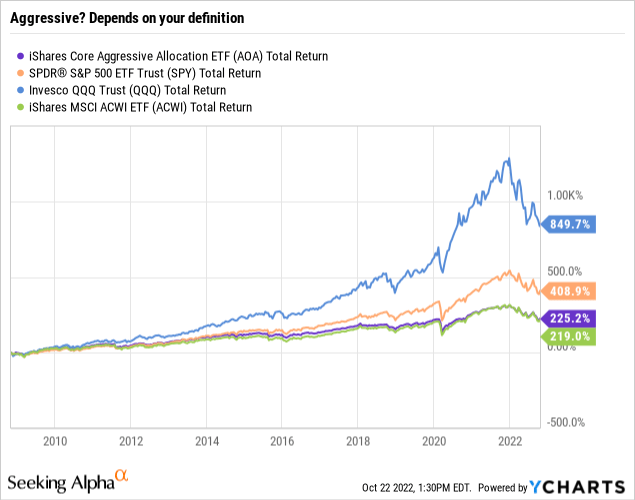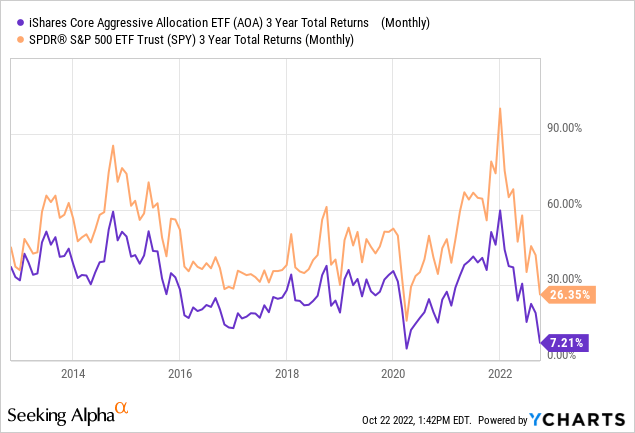brainmaster/E+ via Getty Images
By Rob Isbitts
Summary
The iShares Core Aggressive Allocation ETF (NYSEARCA:AOA) is an “all-in-one” allocation fund aimed at aggressive investors. We rate it Strong Sell because its “cookie-cutter” structure and the fading allure of the stock-bond asset allocation mix make it somewhere between vulnerable and irrelevant in today’s evolving markets.
Strategy
The investment seeks to track the investment results of the S&P Target Risk Aggressive Index composed of a portfolio of underlying equity and fixed income funds intended to represent an aggressive target risk allocation strategy. The fund is a fund of funds and seeks its investment objective by investing primarily in underlying funds that themselves seek investment results corresponding to their own respective underlying indexes.
Proprietary ETF Grades
-
Offense/Defense: Offense
-
Segment: Asset Allocation
-
Sub-Segment: Aggressive Allocation
-
Correlation (vs. S&P 500): High
-
Expected Volatility (vs. S&P 500): High
Holding Analysis
AOA holds 8 ETFs. Not by coincidence, all 8 are iShares ETFs. I am a fan of iShares, and more power to them that they package up their popular ETF products into a variety of allocation mixes. I love the “all in one” concept, and it has a place in the investment business. So, all due respect to iShares for making this available.
However, that doesn’t mean we have to use it. My concern is that while these pre-set mixes (80% stocks and 20% bonds in this case) is traditional and popular, it is increasingly out of touch with what is likely to work in the markets going forward. More in this below.
Strengths
AOA does what it says it does. It allocates about 80% to stocks, 20% to bonds, invests globally, and gives investors a one-stop shop for an allocated portfolio. For an investor who has decided that such a mix is better than paying a financial advisor a lot more money, just to construct a similar mix (and probably with BlackRock’s iShares in many cases!), AOA is sort of a default option. But that’s about the most backhanded compliment we can give any ETF.
Weaknesses
Despite the idea that this is a “balanced” allocation ETF, the fact is that as of Q4 2022, over 43% of this fund’s total exposure is to the S&P 500. That high and exposure to any investment style means that its total return is likely to be highly-correlated to that style. So, it will be a while until AOA can truly differentiate itself from being an S&P 500 fund plus a bunch of asset classes that don’t add value (higher return or less risk) to that core S&P 500 allocation.
There’s also the “self-dealing” aspect of any fund of funds like AOA. It’s a double-edged sword. iShares are used inside the product, which is why the issuer only needs to charge 0.12% Expense Ratio. That looks good if you are screening for “low-cost ETFs,” but it hides the fact that all of the underlying investments are…you guessed it…iShares funds. So, it’s like the old Saturday Night Live skit with Bill Murray and John Belushi. They work in a diner, and the only thing on the menu is cheeseburgers. BlackRock is only going to consider their own products for this allocated ETF. That’s efficient, but a weakness, because it severely limits the opportunity set.
Opportunities
The graph below summarizes the one main bullish point I can make on AOA looking forward. Since its inception in late 2008, it has underperformed popular “aggressive” indexes like the Nasdaq 100 and S&P 500 by such a wide margin, if those two icons falter in an extended bear market, AOA could be poised to outperform.

But as you can see, AOA’s return (purple line) over that entire time has been about equal to the 100% equity-allocated MSCI World Index (green line). In other words, AOA kept pace with the all-stock index, despite having the expected “cushion” of a 20% bond allocation. Times have changed for bonds, but perhaps the key optimistic point one can have for AOA in the future is that non-U.S. stock markets and bonds far outperform the S&P 500 Index. That’s asking a lot.
Threats
While writing a research report on an ETF typically entails pointing to vulnerabilities in the fund itself (and as discussed above, there are plenty!), the biggest “threat” I see in AOA is not in the ETF itself. After all, it does what is says it does: targets and 80/20 stock bond allocation.
Where’s the threat? It’s to the investor, who mistakenly believes that this is a good way to be “aggressive.” As with other stock-bond mixes, a big segment of the financial advisor population still hasn’t gotten the message that markets have changed. The stock/bond paradigm is at least threatened, and at worst gone for a generation. 40 years of falling interest rates and easy central bank policy are behind us, and that means bonds are no longer Robin to stocks’ Batman, so to speak. So, the threat is advisors (or investors themselves) thinking this is something it’s not, then being disappointed when they realize this is the case.
Proprietary Technical Ratings
-
Short-Term Rating (next 3 months): Sell
-
Long-Term Rating (next 12 months): Sell
AOA: 100% underperformer to S&P 500. (Ycharts)
Conclusions
ETF Quality Opinion
As noted, AOA does what it is supposed to do. But that doesn’t mean we have to like it. There are so many better ways to “invest aggressively” that don’t involve a cookie-cutter, old-fashioned stock-bond allocation mix. That era is over, and that’s why I encourage investors to look elsewhere if they want to be aggressive in part of their portfolio. There are plenty of industry, sector and thematic ETFs around that have a better reward/risk profile than AOA. This should particular be the case when the next bull market begins (whatever year that happens to occur).
ETF Investment Opinion
I rate AOA a Sell. It is not a Strong Sell at this point, only because there is some technical (chart) potential for another bear market bounce. And, AOA is already down more than 20% year to date as of this writing. By the way, that’s about even with the S&P 500. So, in a year when the whole “stock/bond asset allocation” concept was truly put to the test, AOA, the proxy for aggressive investing, the billion-dollar ETF that has trailed the S&P 500 in every 3-year period during the past decade…trails it again this year. There are better ways to be aggressive.


Be the first to comment